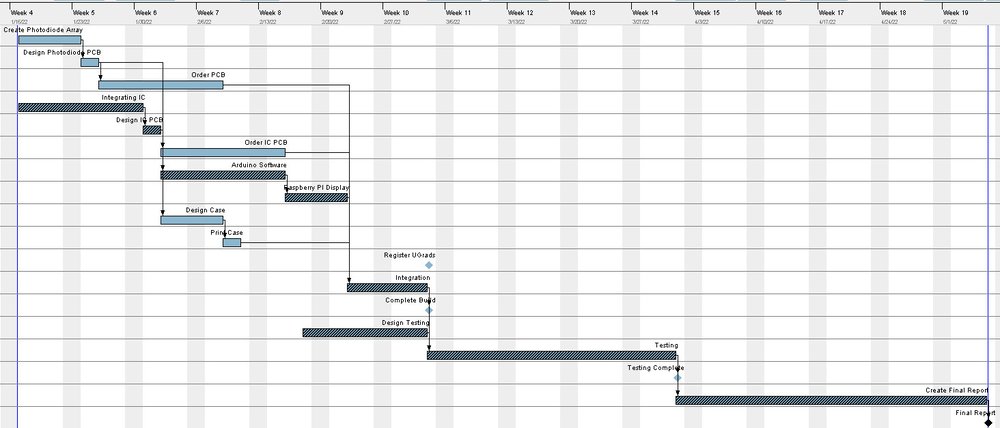
Our plan for Spring 2022
This spring 2022 semester, our team came together to create a plan for what we will need to accomplish during the semester. Our team used a Gantt chart to help organize what needs to be done, as well as calculate the critical path. The critical path is the path that shows us what task needs to be done to not delay the overall project completion date. In the Gantt chart, you will see that we plan to create and finish our design by 3/6/2022. After full completion of our build, we will then move on to our testing phase which is when we collect data on our results and how it meets our requirements for a well-designed product. When our team has fully worked out everything, the semester finishes off with a final report which will consist of everything we did during the semester.
3/11/2022 Update
Currently, our team has finished all the individual systems inside our project. We have yet to start integration, putting us behind on our Gantt chart. To make up for this, we will likely have to complete testing in a shorter time span. With the increased amount of free time during spring break, we expect to get a majority of the testing done with integration testing being done after that.
4/29/2022 Update
Our team has gone through some setbacks, but we were still able to manage to complete our capstone project on time. Currently, our team has completed all of the goals that were set in the Gantt chart. We have a complete device which provides a solution to the main project problem; We gained knowledge and learned valuable lessons that were along the way. Our team developed major technical skills such as creating 3D printing designs and designing PCBs, as well as increasing our programming knowledge of Bluetooth software in Arduino and Raspberry Pi. Not only did we develop technical skills, we developed life long learning skills that can be applied elsewhere other than school. Skills such as problem solving, project management, and communication were sharpened which helped us become better engineers.
Testing
Our team is planning on completing a minimum of 4 different tests to ensure that our design meets the requirements. These 4 tests will consist of 1 matrix unit test, 2 step-by-step unit tests, and an integration test. The matrix unit test will collect data on the voltage and current output of the photodiode array while changing the distance the infrared light source is from the array. This test will confirm that the photodiode array will output the required voltage and current. The 2 step-by-step unit tests will consist of one testing the wireless communication and the other testing the operating temperature of the charge management system. The wireless communication test will ensure that the wireless communication between the Arduino and the external display translates perfectly and displays the charge level and charge rate. The operation temperature test will ensure that the operation of the charge management system while at rest and while working emits a temperature below 95F. The final test that will be done will be the battery management system test. This test will ensure that all of the components work together and the battery charge management system does not overcharge the battery as well as disable the integrated circuit when the battery is at 3.5V. Above is an image showing all the requirements we will test against, with what type of test will be done with each.